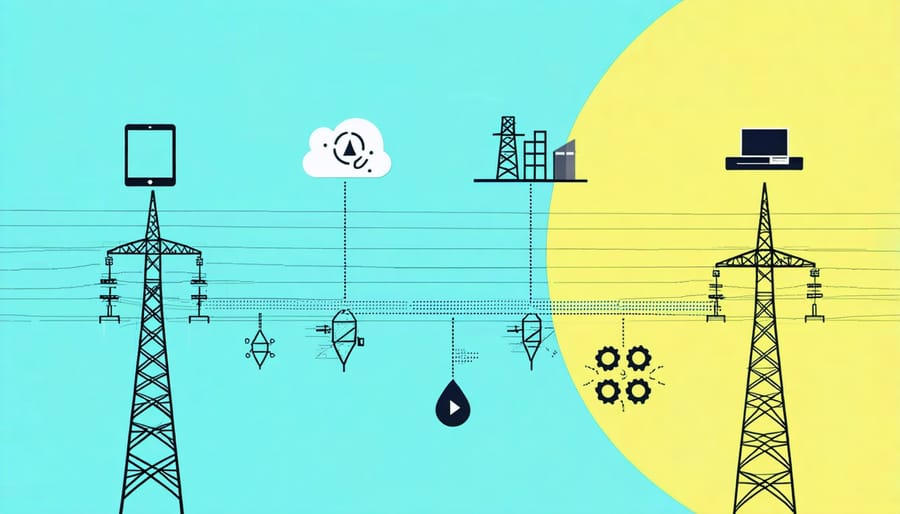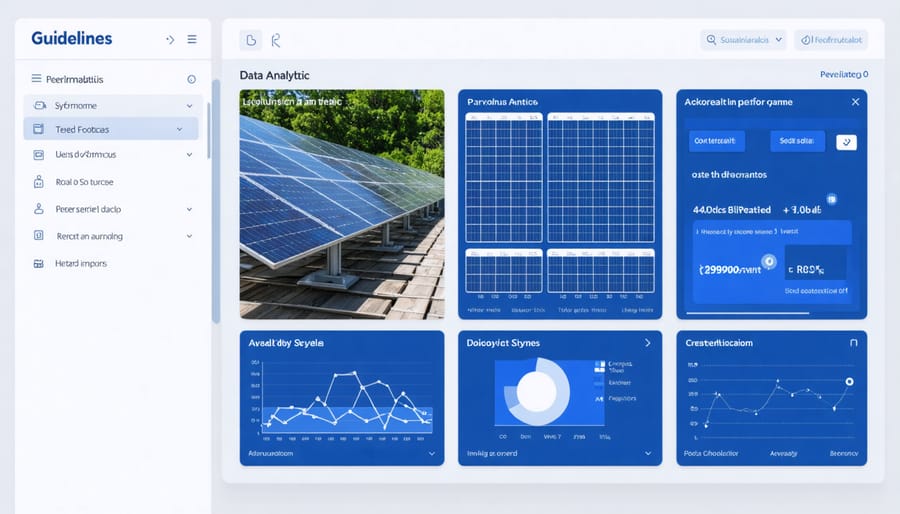The convergence of Internet of Things (IoT) technology with energy management systems is revolutionizing how businesses optimize their power consumption and sustainability initiatives. Smart sensors, real-time monitoring, and automated control systems now enable facility managers to reduce energy costs by up to 30% while maintaining peak operational efficiency. Through sophisticated IoT networks, organizations can track energy usage patterns, predict maintenance needs, and automatically adjust consumption based on real-time demand – creating an intelligent ecosystem that optimizes both renewable and traditional energy sources.
Leading companies implementing IoT-enabled energy solutions have reported significant ROI within 12-18 months, primarily through reduced waste, improved grid stability, and enhanced operational intelligence. The technology’s ability to provide granular insights into energy consumption patterns, combined with machine learning algorithms that continuously optimize performance, offers unprecedented control over energy infrastructure. For facility managers and business leaders, this represents a critical opportunity to drive both sustainability goals and bottom-line results through data-driven energy management.
This sophisticated integration of IoT technology with energy systems marks a fundamental shift from reactive to proactive energy management, enabling organizations to build more resilient, efficient, and sustainable operations for the future.
Smart Sensors: The Brain Behind Modern Solar Grid Management
Real-Time Performance Monitoring
IoT sensors are revolutionizing how we monitor and optimize solar energy systems through real-time solar monitoring. These sophisticated sensor networks collect and analyze crucial performance metrics across multiple parameters, enabling facility managers to make data-driven decisions that maximize energy production and system efficiency.
Advanced IoT sensors track key performance indicators including panel temperature, solar irradiance levels, and power output in real-time. Weather stations integrated into the monitoring system provide essential environmental data such as ambient temperature, wind speed, and cloud cover, allowing for accurate performance forecasting and maintenance scheduling.
The collected data is processed through smart algorithms that detect performance anomalies, predict potential issues, and automatically adjust system parameters for optimal output. Dashboard interfaces present this information in easy-to-understand visualizations, enabling facility managers to monitor system health, track energy production trends, and generate detailed performance reports.
This comprehensive monitoring approach helps organizations identify inefficiencies quickly, reduce downtime through predictive maintenance, and maximize their return on investment in solar infrastructure. The system’s ability to integrate with existing building management systems ensures seamless operation and enhanced overall energy management capabilities.

Predictive Maintenance Capabilities
Modern IoT sensors and predictive maintenance systems revolutionize energy infrastructure management by continuously monitoring equipment performance and environmental conditions. These sophisticated devices collect real-time data on critical parameters such as temperature, vibration, power output, and component wear, enabling facility managers to identify potential issues before they escalate into costly failures.
Through advanced analytics and machine learning algorithms, IoT systems can detect subtle changes in equipment behavior that might indicate developing problems. For instance, unusual vibration patterns in solar inverters or unexpected fluctuations in power generation can trigger early warning alerts, allowing maintenance teams to address issues proactively rather than reactively.
This predictive approach typically reduces maintenance costs by 20-30% and extends equipment lifespan by up to 25%. Furthermore, the system’s ability to optimize maintenance schedules helps organizations minimize downtime and maintain peak operational efficiency. Real-world implementations have shown that IoT-enabled predictive maintenance can prevent up to 70% of equipment failures while significantly reducing emergency repair costs.
Energy Optimization Through IoT Integration

Automated Load Balancing
Automated load balancing through IoT technology represents a significant advancement in energy distribution management, enabling real-time optimization of power flow across the grid. Smart sensors and IoT devices continuously monitor energy demand patterns, generation capacity, and grid conditions to make instantaneous adjustments that maintain system stability and efficiency.
These intelligent systems utilize advanced algorithms to predict peak usage periods and automatically redistribute power loads to prevent overloading and reduce strain on the grid infrastructure. When demand spikes occur in one area, the system can quickly divert power from low-demand zones or activate stored energy resources to maintain consistent supply levels.
For example, a manufacturing facility equipped with IoT-enabled load balancing can automatically adjust its energy consumption based on real-time pricing signals and grid conditions. During peak demand periods, non-essential operations can be temporarily scaled back while critical processes remain fully powered, resulting in significant cost savings and improved grid stability.
The implementation of automated load balancing has shown impressive results across various sectors. A recent case study of a smart city project demonstrated a 15% reduction in peak load demands and a 20% improvement in overall grid efficiency after implementing IoT-based load balancing systems.
This technology also supports the integration of renewable energy sources by managing the intermittent nature of solar and wind power, ensuring smooth power delivery even when generation levels fluctuate. The system can automatically switch between different energy sources and storage solutions to maintain optimal grid performance while maximizing the use of renewable energy.
Smart Storage Solutions
The integration of IoT technology with advanced energy storage solutions has revolutionized how businesses manage and optimize their energy systems. Smart storage solutions leverage real-time data analytics and automated decision-making to maximize energy efficiency and reduce operational costs.
These intelligent systems continuously monitor battery performance, state of charge, and environmental conditions to optimize charging and discharging cycles. Through sophisticated algorithms, they can predict peak demand periods and automatically adjust storage utilization accordingly, ensuring optimal grid stability and cost savings.
Key features of IoT-enabled storage systems include predictive maintenance capabilities, remote monitoring and control, and seamless integration with existing building management systems. The technology enables facility managers to receive instant alerts about system performance, potential issues, and maintenance requirements, significantly reducing downtime and extending battery life.
For example, a manufacturing facility in Melbourne implemented IoT-connected battery storage, resulting in a 30% reduction in peak demand charges and improved grid reliability. The system’s smart forecasting capabilities helped optimize energy consumption patterns by storing excess solar power during low-demand periods and deploying it during peak hours.
These solutions also facilitate participation in demand response programs, creating additional revenue streams for businesses while contributing to grid stability. The integration of artificial intelligence further enhances system performance by continuously learning from usage patterns and adapting storage strategies for maximum efficiency.
ROI and Business Benefits
Cost Reduction Through Efficiency
IoT implementation in energy management systems delivers substantial cost reductions through multiple efficiency channels. Organizations implementing IoT-enabled energy solutions typically report operational cost savings of 20-30% within the first year. These savings stem from automated load balancing, predictive maintenance, and real-time consumption monitoring.
Through advanced sensors and AI-driven analytics, IoT systems optimize energy distribution by identifying peak usage patterns and automatically adjusting power allocation. This intelligent management, combined with smart grid integration benefits, reduces waste and prevents costly demand surges.
Predictive maintenance capabilities significantly lower repair costs by detecting potential equipment failures before they occur. Data from IoT sensors enables facility managers to schedule maintenance during off-peak hours, minimizing downtime and associated revenue losses. Companies implementing these systems report maintenance cost reductions of up to 40%.
Real-time monitoring also enables immediate response to inefficiencies, with automated alerts and remote management capabilities reducing the need for on-site personnel. This automation typically results in labor cost savings of 15-25% while improving overall system reliability and performance.

Enhanced Grid Reliability
IoT technology has revolutionized grid reliability by enabling real-time monitoring and predictive maintenance of energy infrastructure. Smart sensors deployed across the grid continuously collect data on equipment performance, power quality, and environmental conditions, allowing operators to identify potential issues before they escalate into system failures.
Studies show that IoT-enabled grid management systems can reduce maintenance costs by up to 30% while improving system uptime by 15-20%. These improvements stem from the ability to transition from reactive to predictive maintenance strategies, where AI algorithms analyze sensor data to forecast equipment failures and optimize maintenance schedules.
For example, a major utility company implemented IoT sensors across their distribution network and saw a 45% reduction in unplanned downtime within the first year. The system automatically detected voltage anomalies and equipment stress, enabling technicians to address issues proactively.
Advanced IoT platforms also enable self-healing grid capabilities, where the system can automatically reroute power during outages or high-demand periods. This enhanced resilience is particularly valuable for businesses that rely on uninterrupted power supply, as it minimizes the impact of grid disturbances on operations.
Implementation Success Story
The Sunshine Valley Solar Farm’s successful implementation of IoT technology serves as a prime example of smart energy management in action. In 2021, this 50-megawatt solar installation in Arizona integrated an advanced IoT ecosystem that transformed its operations and efficiency metrics.
The facility deployed 2,500 smart sensors across its solar array, connecting them to a centralized management platform. These sensors continuously monitor panel performance, weather conditions, and grid demand in real-time. The system’s predictive maintenance algorithms analyze this data to optimize panel positioning and cleaning schedules.
Within the first year of implementation, the facility reported remarkable improvements. Energy production increased by 23% through optimized panel positioning and reduced downtime. Maintenance costs decreased by 35% as the system identified potential issues before they became critical failures. The smart grid integration enabled dynamic load balancing, resulting in a 15% improvement in grid stability.
The project’s ROI exceeded expectations, with the $2.1 million IoT investment paying for itself in just 18 months. The success has prompted the facility’s operators to expand the system to two additional solar farms, with expected completion in 2024.
Key to this success was the careful planning and phased implementation approach, which included comprehensive staff training and gradual system integration. The project demonstrates how IoT technology can significantly enhance solar energy operations while delivering measurable financial benefits.
The integration of IoT technology in solar grid management represents a transformative leap forward in renewable energy optimization. By enabling real-time monitoring, predictive maintenance, and automated decision-making, IoT solutions have demonstrated significant improvements in system efficiency and cost reduction. The future outlook is particularly promising, with emerging technologies like AI and machine learning further enhancing IoT capabilities in energy management. As more organizations adopt these smart solutions, we can expect to see continued innovation in grid reliability, energy storage optimization, and demand response systems. The combination of decreasing implementation costs and increasing energy savings makes IoT integration an essential strategy for organizations looking to maximize their solar energy investments. Moving forward, IoT will play a crucial role in creating more resilient, efficient, and sustainable energy systems that benefit both businesses and the environment.

